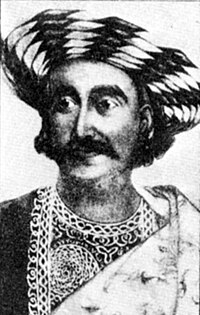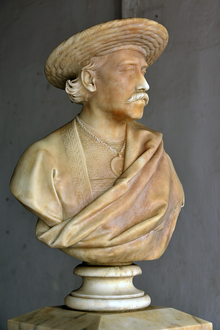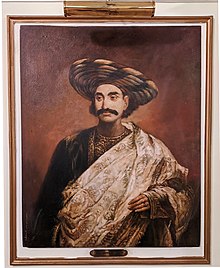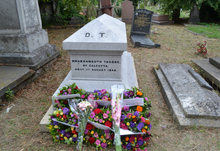Dwarkanath Tagore
 From Wikipedia - Reading time: 10 min
From Wikipedia - Reading time: 10 min
Dwarakanath Tagore | |
|---|---|
 Dwarakanath Tagore | |
| Born | 1794 |
| Died | 1 August 1846 (aged 51–52) |
| Nationality | British Indian |
| Occupation | Industrialist |
| Spouse | Digambari Devi (m.1811 - 1839) |
| Children | 3, including Debendranath Tagore |
| Parents |
|
'Prince' Dwarkanath Tagore (Dwarakanath Ţhakur; 1794–1846) was one of the first Indian industrialists to form an enterprise with British partners.[1] He was the son of Rammoni Tagore, and was given in adoption to Rammoni’s elder brother Ramlochan Tagore. He was the scion of the Tagore family of Calcutta, father of Debendranath Tagore and grandfather of Rabindranath Tagore.
Ancestry
[edit]Dwarakanath Tagore was a descendant of Brahmins of the Kushari division. They were called Pirali Brahmin - the word "Pirali" comes from Pir Ali, a convert to Islam who supposedly dined with and converted two Tagore ancestors. Their relatives, still Hindus, were tainted by association and got the name "Pirali Brahmin".[2][3]
Dwarakanath's great grandfather Jairam Tagore made a large fortune as a merchant and as Dewan to the French government at Chandannagar. He shifted from Gobindapur to Pathuriaghata, when the British constructed the new Fort William in the mid-eighteenth century. His eldest son, Nilmoni Tagore (b.1721 - d.1791), with his wife Lalita Devi and sons, settled at Jorasanko after leaving the ancestral house at Pathuriaghata following a rift with his younger brother Darpanarayan Tagore. Nilmoni Tagore built the Jorasanko Thakur Bari where the Jorasanko branch of the family dwelled, while Darpanarayan Tagore's descendants belonged to the Pathuriaghata Tagore branch.[4]
Childhood
[edit]Nilmoni's grandson, Dwarakanath Tagore, was born in 1794 to Rammoni Tagore and his wife Menaka Devi. Soon after birth, he was given in adoption to Rammoni's childless elder brother Ramlochan (b.1759 - d.1807), a rich man of his time and a patron of music. Menaka Devi was the younger sister of Dwarakanath's adoptive mother Aloka Sundari Devi.[5]
Dwarakanath studied at the English-medium school of Mr. Sherbourne. In 1807, Ramlochan died leaving a considerable inheritance in trust to Dwarakanath, who was then a minor aged 13. This property consisted of the zamindari Berhampore, estates in Orissa, and urban holdings in Calcutta.[6] Dwarakanath left school in 1810 at the age of 16 and apprenticed himself under renowned barrister, Robert Cutlar Fergusson and traveled between Calcutta and his estates at Behrampore and Cuttack.[citation needed]

Marriage
[edit]At the age of 17, Dwarakanath married the 9 years old Digambari Devi, daughter of a zamindar from near Jessore, in 1811. They had 4 sons and 1 daughter - among whom 3 survived - Debendranath Tagore (b.1817), Girindranath Tagore (b.1820 - d.1854) and Nagendranath Tagore (b.1829 - d.1858). As Dwarakanath started leading an extravagant lifestyle, his married life with his orthodox Hindu wife got strained. She consulted with Hindu Brahmins regarding his behaviour and finally decided to stop interaction with her husband. Whenever she had to speak to him regarding household matters, she used to take a bath in the holy Ganges water. It continued this way for some time. However, after taking such a bath in a cold winter night, Digambari caught fever, and died in 1839 at the age of 37.[7]
Business life
[edit]
Tagore was a western-educated Bengali Brahmin and a civic leader of Calcutta who played a pioneering role in setting up a string of commercial ventures—banking, insurance, and shipping companies—in partnership with British traders. In 1828, he became the first Indian bank director. In 1829, he founded Union Bank in Calcutta. He helped found the first[1] Anglo-Indian managing agency (industrial organizations that ran jute mills, coal mines, tea plantations, etc.,[8]) Carr, Tagore and Company. (Earlier, Rustomjee Cowasjee, a Parsi in Calcutta, had formed an inter-racial firm, but in the early 19th century Parsis were classified as a Near Eastern community as opposed to South Asian.)
Tagore's company managed large zamindari estates spread across today's West Bengal and Odisha states in India, and in Bangladesh, and held stakes in new enterprises that were tapping the rich coal seams of Bengal, running tug services between Calcutta and the mouth of the river Hooghly, and growing tea in Assam.[9]
Carr, Tagore and Company was also engaged in shipping opium to China.[10]

In 1832, Tagore purchased a coal mine at Raniganj, the oldest, largest, and richest coal mine in India. It eventually became the Bengal Coal Company.[11]
Death
[edit]

Dwarakanath Tagore died "at the peak of his fortune"[1] on the evening of 1 August 1846 at the St. George's Hotel in London.
In his obituary, The London Mail newspaper of 7 August wrote:
Descended from the highest Brahmin caste of India his family can prove a long and undoubted pedigree. But it is not on account of this nobility that we now review his life but on far better grounds. However gifted, his claims rest on a higher pedestal – he was the benefactor of his country... They testified to his merits in the encouragement of every public and private undertaking likely to benefit India.[12]
Family tree
[edit]References
[edit]- ^ a b c Wolpert, Stanley (2009) [First published 1077]. A New History of India (8th ed.). Oxford University Press. p. 221. ISBN 978-0-19-533756-3.
- ^ Thompson, E Jr. (1926), Rabindranath Tagore: Poet and Dramatist, Read, p. 12, ISBN 1-4067-8927-5,
The [Tagores] are Pirili Brahmans [sic]; that is, outcastes, as having supposedly eaten with Musalmans in a former day. No strictly orthodox Brahman would eat or inter-marry with them.
- ^ Dutta, K.; Robinson, A. (1995). Rabindranath Tagore: The Myriad-Minded Man. Saint Martin's Press. pp. 17–18. ISBN 978-0-312-14030-4.
- ^ James Wyburd Furrell (1882). The Tagore Family: A Memoir. K. Paul, Trench, & Company. p. 17. Retrieved 5 April 2017.
- ^ Chitra Deb (2018). Thakurbarir Bahirmahal. Ananda.
- ^ Kling, Blair B. (1976). Partner in Empire: Dwarkanath Tagore and the Age of Enterprise in Eastern India. Univ of California Press. p. 15. ISBN 0-520-02927-5.
- ^ Chitra Deb. Thakurbarir Andarmahal. Ananda Publishers.
- ^ Kulke, Hermann; Rothermund, Dietmar (2004) [First published 1986]. A History of India (4th ed.). Routledge. p. 265. ISBN 0-415-32920-5. Retrieved 18 September 2011.
- ^ Kling, Blair B. (1976). Partner in Empire: Dwarkanath Tagore and the Age of Enterprise in Eastern India. Univ of California Press. pp. 94, 123–124, 144–145. ISBN 0-520-02927-5.
- ^ Kling, Blair B. (1976). Partner in Empire: Dwarkanath Tagore and the Age of Enterprise in Eastern India. Univ of California Press. pp. 90–91. ISBN 0-520-02927-5.
- ^ Kling, Blair B. (1976). Partner in Empire: Dwarkanath Tagore and the Age of Enterprise in Eastern India. Univ of California Press. pp. 94, 101. ISBN 0-520-02927-5.
- ^ Kripalani, Krishna (1981). Dwarkanath Tagore, A Forgotten Pioneer: A Life. New Delhi, India: National Book Trust, India. pp. 246–7. ISBN 978-81-237-3488-0.
Further reading
[edit]- NK Sinha, The Economic History of Bengal 1793–1848, III, Calcutta, 1984.
- Sengupta, Subodh Chandra and Bose, Anjali (editors), 1976/1998, Sansad Bangali Charitabhidhan (Biographical dictionary) Vol I, (in Bengali), pp. 223. ISBN 81-85626-65-0
External links
[edit]- Works by or about Dwarkanath Tagore at the Internet Archive
- Islam, Sirajul (2012). "Tagore, Prince Dwarkanath". In Islam, Sirajul; Jamal, Ahmed A. (eds.). Banglapedia: National Encyclopedia of Bangladesh (Second ed.). Asiatic Society of Bangladesh.
 KSF
KSF